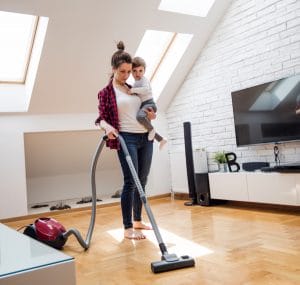 Photo: Getty
Photo: Getty Everyone wants to live in a healthy home, but life is busier than ever. Who has time for a huge overhaul? Fortunately, there are plenty of things you can do that take almost no time and won’t break the bank, but they can make a huge difference for people living with allergies and asthma.
From patching up cracks where water can get in to ditching nasty chemical cleaners, we’ve gathered 15 weekend home projects you can tackle this spring and summer.
1. Shingle Alert
If you want to keep mold and dust out, the key is to keep moisture out too – and that means starting at the top. Go outside and look up at your roof: is there staining on the shingles? Are any worn, curling or missing? These are hints that it could be time for a fix. Inside your attic, look for signs of staining, mold or water leaks, and no matter how small the problem, fix it right away. Roofs can be costly to repair and replace, but the longer you wait, the more pricey that repair becomes – especially if mold takes hold.
“People over-extend the life expectancy of their shingles,” says Scott McGillivray, star of home reno shows Vacation House Rules and Income Property. “They say, ‘It’s fine, it’s not leaking,’ but then it starts leaking like crazy,” he says. “They wait until it’s too late.”
2. Go Hard Materials
Old rugs and upholstered furniture can be magnets for dust mites, mold spores and VOCs, so bid goodbye to that old easy chair or beaten-up area rug, then shop for wood or leather furniture that’s attractive, easy to clean and allergy-friendly.
If you don’t want to break the bank, hit online classifieds or salvage sales. In general, pass on anything made from particle board, which can emit high levels of VOCs – although some manufacturers, including IKEA, offer no-added formaldehyde options. While you’re at it, swap out your curtains – also hideouts for dust mites – with easy-to-clean horizontal or vertical blinds.
 Photo: Getty
Photo: Getty 3. Gutters and Downspouts
Gutters (or “eavestroughs”) are essential to moving water away from your home, which helps to keep it free from mold, rot, pests, and other household woes. Problem is, gutters get clogged with leaves, sticks and other debris; wind, ice and tree branches can also give them a serious beating, leaving them damaged. For an important home project, do a careful inspection and make sure they are intact and fully connected. Then get on a ladder to ensure they’re free of leaves and debris.
Also check that your downspouts are draining at least a few feet from your home. If your gutters are hard to get to, hire professionals; usually it’s an inexpensive job.
4. Encase Mattresses and Pillows
Dust mites love warm, moist environments, and when people sleep in their beds, they provide a steady supply of the allergenic insects’ favorite food: skin cells. Fortunately, most major home stores and bedding shops carry mattress encasements and pillow protectors that prevent dust mites from setting up shop.
Buy ones that are tightly woven, go all the way around the mattress, and are labeled specifically for dust-mite protection. (The microscopic mites can get through a looser weave.) Also launder your bedding at least once a week in hot water, and wash kids’ plush toys regularly.
5. Pet Beds and Toys
People love their pets – but little Fido and Fifi can track in unwanted moisture and pollen. What’s more, since their beds tend to be warm and humid, they’re a haven for dust mites and mold spores. Regularly wash and thoroughly dry pets’ bedding and soft toys.
Also pick up microfiber towels that come in large packs at big box stores – these are great for drying pets thoroughly when they come inside. For a larger pooch, buy water-resistant beds with washable zip-off covers. And keep bedrooms a pet-free zone.
 Photo: Getty
Photo: Getty 6. Get Caulking
One of the most common sources of moisture is plumbing leaks, which can happen under sinks, in walls and even in ceilings. Look for evidence of moisture near plumbing lines, especially in sink cabinets or near baseboards. Also, if the caulk around your bathtub or sinks is old and no longer keeping moisture out, use a caulk remover tool – available at home reno stores – to cut out the old. (A hair dryer can help soften the old caulk, too.)
Clean the area, apply the new caulk in a long thin strip, then gently run your finger along it to give it that smooth, even look. Afraid you’ll mess it up? Check out a few YouTube videos first.
7. Look for Cracks
Go outside and check for cracks in your siding, whether it’s wood, vinyl, stucco or another material. If you have brick or stone, keep an eye out for cracks in the mortar. Look extra carefully around windows, doors, skylights and other openings where gaps can occur. Even the tiniest breaks can bring water in, and lead to mold, dust mites, pests and other problems, so it’s important to patch and re-seal as needed – and if you’re unsure, call a pro.
“Wind can drive rain horizontally, and right into your house,” says McGillivray. “You need to keep that seal consistent from the top of the roof all the way down to the bottom of the foundation.”
8. Snuff Out Flames
One of the biggest sources of home air pollution is indoor burning. Incense, scented candles, ventless fireplaces and other combustion-based products are especially good at releasing harmful compounds, so kick them to the curb and up your ventilation.
“Anything that’s combustible you have to be careful about,” says Dr. James Sublett, an allergist and managing partner for Family Allergy and Asthma in Louisville, Kentucky. “Some air fresheners emit VOCs that can be irritating, but the plug-in air fresheners can also emit small particles. People don’t realize that.”
Concerns are also rising about air quality and gas stove emissions, particularly for those with respiratory conditions. Always use the range hood when cooking with natural gas, says Sublett, and get your gas appliances checked and serviced regularly to make sure they’re exhausting properly.
 Photo: Getty
Photo: Getty 9. Purge the Chemicals
When you have people with allergies and asthma in the home, it’s crucial to keep it clean, but many cleaning products – from disinfectants to furniture polishes – contain ingredients that can trigger asthma, atopic dermatitis and other reactions.
So turf those troublemakers and opt for natural cleaners such as soap, vinegar, baking soda and water wherever possible. If you must use a chemical product, choose a scent-free one that is certified green by a reputable organization such as the EPA’s Design for the Environment program at epa.gov/dfe. (In Canada, see ecologo.org).
Avoid scented products such as air fresheners, diffusers, detergents and fabric softeners; they seriously compromise your indoor air quality – and can be potent asthma triggers.
10. Up Your Insulation
Insulation helps to keep your home cool in summer and cozy in winter. It also helps to keep down condensation and reduces other moisture-related problems such as ice dams. So up your R-value in attics, walls, and basement spaces by adding insulation; just opt for products that don’t off-gas formaldehyde or other volatile organic compounds. Favorites include UltraTouch batts, which are made from recycled blue jeans, and Roxul, which is made from mineral wool.
If you install it yourself, follow the instructions carefully and check out the videos on the manufacturers’ websites, because even small gaps can make a big difference. Other options include blown-in cellulose, typically made from recycled newsprint, and Airkrete, an environmentally friendly foam, which you can DIY, but it’s usually best left to the pros.
11. Change the Furnace Filter
If you have a forced air heating and cooling system and you haven’t changed the filter lately, you could be blasting mold spores, VOCs, pollen and other triggers throughout your home. Hit the home improvement store and swap out that filter every three months. Look for allergy-minded filters that have a MERV rating of 11 or 12. Not sure what size you need? Check the side of your old filter. Sublett also recommends ordering a FilterLOCK furnace slot cover, which makes sure polluted indoor air doesn’t bypass the filter.
12. Acknowledge Your Fans
Kitchen and bath fans are key to removing moisture and kicking out polluted indoor air. But check to see they are actually venting to the outside. Poorly installed fans can end up venting into walls or attic spaces, which can lead to mold and other issues; some aren’t connected at all. Follow the vent pipe, see where it leads, and check that it’s blowing out.
 Photo: Getty
Photo: Getty 13. Hit the Basement
Below-grade spaces are notorious for trapping moisture and offering a breeding ground for mold – especially if they’re packed with boxes of stuff or finished with carpeting and upholstered furniture. If your basement feels damp, pick up a humidistat or hygrometer and measure your moisture level. If it’s over 50 percent, you’ll want to run a dehumidifier and up your ventilation.
Also do a visual inspection with this home project: if the walls are finished, check for signs of mold or expanded drywall. Look as well for cracks in the foundation, which often start around windows. If the basement smells musty, that’s a sure sign you have a problem, and need to start taking steps to tackle the mold.
 Photo: Getty
Photo: Getty 14. A Deeper Clean
It’s important to clean and vacuum regularly, but once in a while, make sure to go deep, getting into cabinets and behind furniture and appliances where dust can hide and mold can form. You don’t need heavy-duty cleaners, just elbow grease and a little soap, water and vinegar. If you don’t already have one, pick up a vacuum with HEPA filtration, which keeps fine particles that trigger asthma from blowing out the vacuum’s exhaust. If you have a HEPA vacuum, check the filter to see if it’s time for a change.
15. Clean Your Dryer Vent
Most people clean their dryer’s lint trap every cycle, but when was the last time you cleaned your dryer exhaust vent? If it was more than a year ago, it’s time, because a blocked vent not only causes moist, particulate-filled air to be pushed back into your home, it’s a fire hazard. For around $20 you can pick up a dryer vent cleaning kit at a home reno store – it’s basically a long flexible rod with a brush at the end.
If you have a forced-air heating system, Sublett recommends removing the registers and vacuuming out the ducts as far as the hose will reach. This home project helps prevent dust and debris from getting blown back into your living spaces.
Taking these small steps won’t fix your allergies, but Sublett says they can go a long way toward minimizing mold, dust mites, VOCs and other allergy and asthma triggers, which keeps everyone breathing easier. “You don’t need to spend thousands of dollars. The key is doing these simple things,” he says. For example, for about $60 a year you can get high-quality furnace filters and change them regularly, but that can make a big difference.
“These measures are not going to reverse the disease process, but they’ll stop the continuation of it. We know that from studies,” Sublett says. “So anything you do, you’re going to be better off.”
Read More:
Allergic Living’s Go-To Goods for Renovating with Environmental Allergies
TV Reno Expert’s Advice: How to Keep Water, Mold and Pests Out of Your Home
Mold: What Are Its Effects on Health?





